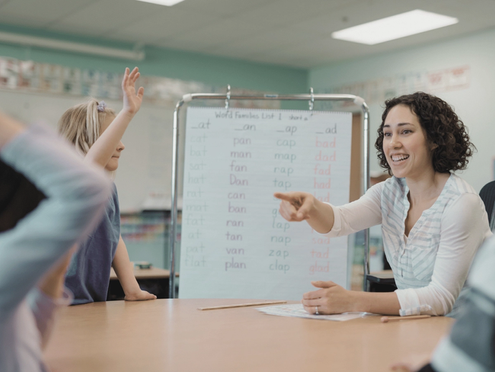An overview of Rosenshine's principles
Barak Rosenshine is undoubtedly the current flavour du jour in terms of guiding theory in schools across the UK. His work draws heavily on the perspective of cognitive science which seeks to explain human behaviour and experience on a neural and psychological basis. The cognitive science approach uses objective methods to consider how we think, how we remember things and how we process language.
Memory stores
From the cognitive science perspective, learning becomes essentially ‘memorisation’ of information. The assumption is that memory consists of short-term memory memory (STM), working memory and long-term memory (LTM) stores – STM having an extremely limited capacity, working memory having capacity for a learner to use and manipulate information and LTM with an infinite capacity.
In order for information to be considered ‘learned’, it needs to move from the working memory, where it is being paid attention to in the moment (or being ‘worked’ on), to LTM.
Rosenshine's 10 principles of instruction
Rosenshine himself was a history teacher and was in a position to understand which aspects of the research concerning processing information could be most useful in classrooms. He drew out what he felt were the most important elements and developed 10 principles of effective instruction, grounded in cognitive research and evidence:
- Daily review
- New material in small steps
- Ask questions
- Provide models
- Guide student practice
- Check student understanding
- Obtain a high success rate
- Scaffold for difficult tasks
- Independent practice
- Weekly and monthly review
Rosenshine actually whittled his original 17 point list down to this more slimline 10 point list which details ways of helping learners remember information. However, 10 points are still a large number of items for teachers to draw on when trying to plan sequences of learning for every taught session.
Why Tom Sherrington developed 4 strands
As a fellow educationalist, Tom Sherrington recognised the potential difficulty for teachers to apply 10 principles in a practical context; looking closely, he noticed that there were four common strands running throughout them. Drawing out these strands makes the principles easier for teachers to understand, develop and apply in their everyday practice. Sherrington combined 2 or 3 of Rosenshine’s principles into each strand as follows:
Strand 1: Reviewing material
For the first strand, Sherrington paired the first and last of Rosenshine’s principles – daily review and weekly/monthly review. These principles focus on the review of material already learned by the student and on retrieving this information from the long-term memory. For example, reviewing material learned in their last taught session enables learners to move this already learned content to their working memory, allowing them to make sense of the new material about to be taught.
The act of reviewing material through weekly or monthly reviews provides opportunities for re-engagement with already learned material. This re-engagement enables the information to be more effectively stored in the LTM. Essentially, the more a learner draws on stored content, the more effective they become at recalling it and using it to develop their understanding of new material.
Strand 2: Questioning
For Sherrington’s second strand, he combines principles 3 and 6 – ask questions and check student understanding. Questions require learners to adapt their knowledge store, to critique it and (where necessary) to adapt it.
Furthermore, effective questioning enables teachers to understand where misconceptions may lie and where taught input might be required to help the learner modify knowledge they have memorised. To do this effectively, Rosenshine surmised that teachers need to ask process questions, which aim to find out how a learner has worked things out, and not be satisfied with just giving a correct answer.
Effective questioning can also highlight times when teachers may need to adapt their methods of teaching. For example, when learning about electricity as a flow of electrons, the abstract nature of this invisible behaviour might lead to some misconceptions in learners’ understanding. Effective questioning about their understanding of this phenomena might lead a teacher to re-approach their description of this using an analogy of a flowing river to help learners make links between new information and concrete examples they are already familiar with.
Strand 3: Sequencing concepts and modelling
Sherrington combines 3 of Rosenshine’s principles for his third strand which concern the sequencing of knowledge – learn new material in small steps, provide models and scaffold for difficult tasks. Here we need to harness our understanding of memory storage to remember that working memory capacity is finite - when learning new information, learners need to process small amounts at a time to then store it in their long-term memory. Trying to work with large amounts of new information means that some will not be processed.
Presenting learning in small steps allows learners to master new information in small chunks before providing more of the new information. Furthermore, new information often needs some kind of cognitive support for its processing to be successful, such as providing models and scaffolded support which is slowly removed. This allows students to apply their new learning to solving problems.
Strand 4: Stages of practice
Sherrington’s final strand takes the remaining 3 of Rosenshine’s principles, looking at developing students’ independence in their learning. This starts with principle 5 - guide student practice - which focuses on learners having time to rehearse, elaborate and rephrase the new material so that it can be processed in their long-term memory storage.
Principle 8 is to obtain a high success rate, meaning that teachers should monitor the accuracy of the new learning - 80% is an optimal degree. When the teacher is confident that the student is secure in the new learning, principle 9 of independent practice comes in, where overlearning the material leads to automatic retrieval. This is desirable because it frees up working memory – if information is automatically recalled, then we can be sure that it is stored in long-term memory and not taking up working memory capacity.
How the 4 strands of Rosenshine help teachers
As you can see, Sherrington’s 4 strands provide a useful structure for teachers to develop effective practice. Indeed, Rosenshine’s 10 principles risk being used as a checklist (which is not the intention and not easily achievable as such). Instead, each of Sherrington’s strands can be a focus area for improvement for practice and relates teaching back to recapping prior learning, learning new information, then applying, checking and responding to this new content. So how can teachers improve their practice in each strand?
Teachers first need to understand the model of memory storage; new learning is going to have a stronger chance of being stored in LTM if it can be combined with information the learner already holds. Therefore, taking time to draw out prior knowledge at the start of a learning sequence will allow learners to work with information already stored. This can be achieved through using quizzes, group discussions and using stimuli and questioning to draw out their current understandings.
If learners do not retrieve information often enough it will be forgotten. Therefore, regular retrieval should be embedded in learning sessions over the course of the days, weeks and months.
Teachers should plan questions which encourage students to re-engage with the information they have learned and explain their thinking. This will allow teachers to check if incorrect information has been stored and needs to be relearned or if the learners are struggling with particularly abstract concepts which need more careful scaffolding or modelling. It can also indicate if the learner is secure and ready for their thinking to be deepened.
In order to prevent information loss from working memory, teachers should check that they have planned to break down new information into small bite-sized pieces. They should support learners to make links to information they already hold and provide models and scaffolds where possible to support learners in doing this.
Finally, teachers should ensure that students have opportunities for frequent rehearsal of material they have learned. Opportunities for this might occur in a cross-curricular context where students can be encouraged to make links between subjects and areas of learning. The more often they can retrieve and apply their learning the more chance that this information will be firmly embedded in LTM.
Conclusion
These overarching cognitive approaches can be applied to any subject at any level, from early years right through to postgraduate level, because Rosenshine has looked at how we all learn and process information at a cognitive level.
Whether you teach English, Spanish or drumming lessons, the principles are the same. Sherrington’s four strands form a useful blueprint for helping someone learn new information in any discipline.




